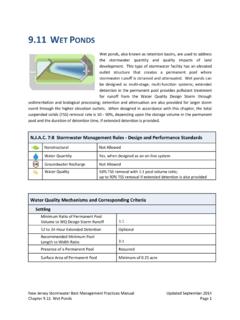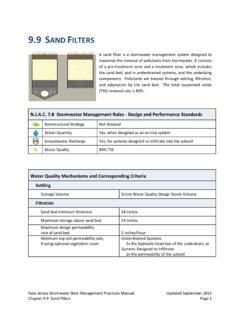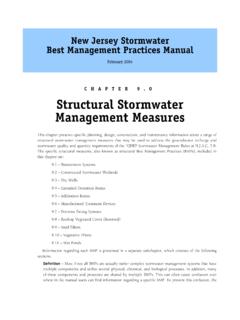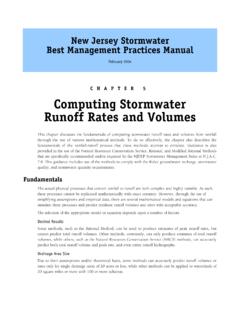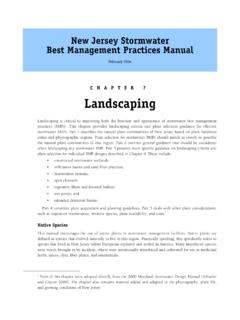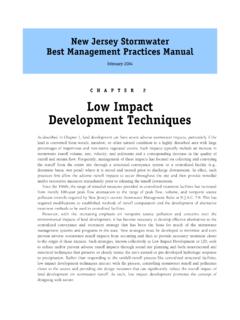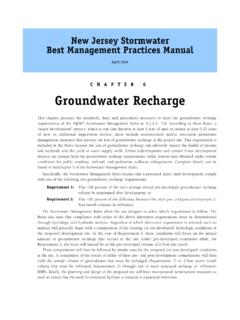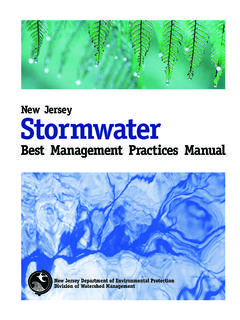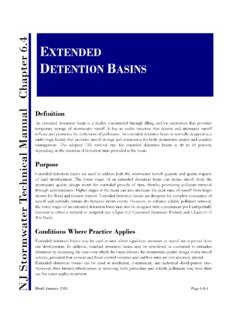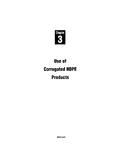Transcription of CHAPTER 9.4 Standard for Extended Detention …
1 New Jersey StormwaterBest Management Practices ManualFebruary 2004 CHAPTER for ExtendedDetention BasinsDefinitionAn Extended Detention basin is a facility constructed through filling and/or excavation that providestemporary storage of stormwater runoff. It has an outlet structure that detains and attenuates runoff inflowsand promotes the settlement of pollutants. An Extended Detention basin is normally designed as a multi-stage facility that provides runoff storage and attenuation for both stormwater quality and quantitymanagement.
2 The adopted TSS removal rate for Extended Detention basins is 40 to 60 percent, dependingon the duration of Detention time provided in the Detention basins are used to address both the stormwater runoff quantity and quality impacts ofland development. The lower stages of an Extended Detention basin can detain runoff from the stormwaterquality design storm for Extended periods of time, thereby promoting pollutant removal throughsedimentation. Higher stages in the basin can also attenuate the peak rates of runoff from larger storms forflood and erosion control.
3 Extended Detention basins are designed for complete evacuation of runoff andnormally remain dry between storm events. However, to enhance soluble pollutant removal, the lowerstages of an Extended Detention basin may also be designed with a permanent pool and partially function aseither a wetland or retention basin (see CHAPTER : Standard for Constructed stormwater Wetlands andChapter : Standard for Wet Ponds).Conditions Where Practice AppliesExtended Detention basins may be used at sites where significant increases in runoff are expected from sitedevelopment.
4 In addition, Standard Detention basins may be retrofitted or converted to Extended detentionby increasing the time over which the basin releases the stormwater quality design storm runoff volume,provided that erosion and flood control volumes and outflow rates are not adversely Detention basins can be used at residential, commercial, and industrial development , their limited effectiveness in removing both particulate and soluble pollutants may limit their usefor water quality Jersey stormwater BMP Manual CHAPTER .
5 Standard for Extended Detention Basins February 2004 Page , an Extended Detention basin must have a maintenance plan and, if privately owned, should beprotected by easement, deed restriction, ordinance, or other legal measures that prevent its neglect, adversealteration, and CriteriaThe basic design parameters for an Extended Detention basin are its storage volume and Detention time. Anextended Detention basin must have the correct combination of storage volume and outflow capacity tocontain and slowly discharge the design runoff volume over a prescribed period of time.
6 Details of these andother design parameters are presented below. The components of a typical Extended Detention basin areshown in Figure : Extended Detention basin ComponentsSource: Adopted from Pennsylvania Handbook of Best Management Practices for Developing Areas, which adapted the figure from Dam Design and Construction standards , Fairfax County, Jersey stormwater BMP Manual CHAPTER : Standard for Extended Detention Basins February 2004 Page storage Volume, Depth, and DurationExtended Detention basins should be designed to treat the runoff volume generated by the stormwaterquality design storm.
7 Techniques to compute this volume are discussed in CHAPTER 5: Computing StormwaterRunoff Rates and Volumes. To achieve a 60 percent TSS removal rate, a minimum of 10 percent of this runoffvolume must remain in the basin 24 hours after the peak basin water surface and maximum runoff storagevolume is achieved. This applies to all types of land should be noted that the time from when the maximum storage volume is achieved until only 10percent of that volume remains in an Extended Detention basin is defined as the basin s Detention time.
8 Asnoted above, a 24-hour Detention time is required in an Extended Detention basin in order to achieve a 60percent TSS removal rate. Figure below can be used to determine the TSS removal rates at extendeddetention basins with Detention times of 12 to 24 hours. The minimum diameter of any outlet orifice mustbe lowest elevation in an Extended Detention basin , excluding low flow channels, must be at least 1 footabove the seasonal high groundwater table. The lowest elevation in any low flow channel, including anyunderdrain pipes and bedding material, must be at or above the seasonal high groundwater enhance safety by minimizing standing water depths, the vertical distance between the basin bottomand the elevation of the first stormwater quantity control outlet (normally set equal to the maximumstormwater quality design storm water surface) should be no greater than 3 feet wherever : TSS Removal Rate vs.
9 Detention TimeNew Jersey stormwater BMP Manual CHAPTER : Standard for Extended Detention Basins February 2004 Page OverflowsAll Extended Detention basins must be able to safely convey system overflows to downstream drainagesystems. The capacity of the overflow must be sufficient to provide safe, stable discharge of stormwater inthe event of an overflow. Extended Detention basins that are classified as dams under the NJDEP Dam SafetyStandards at 7:20 must also meet the overflow requirements of these TailwaterThe hydraulic design of the outlet structure, outlet pipe, emergency spillway, and underdrain systems in anextended Detention basin must consider any significant tailwater effects of downstream waterways orfacilities.
10 This includes instances where the lowest invert in the outlet or overflow structure is below theflood hazard area design flood elevation of a receiving Other ComponentsInformation regarding outlet structures, bottom and side slopes, trash racks, low flow channels, conduitoutlet protection, and vegetative cover can be found in both the Soil Erosion and Sediment ControlStandards for New Jersey and the NJDEP stormwater Management Facilities Maintenance Subsurface Extended Detention BasinsA subsurface Detention basin is located entirely below the ground surface.
